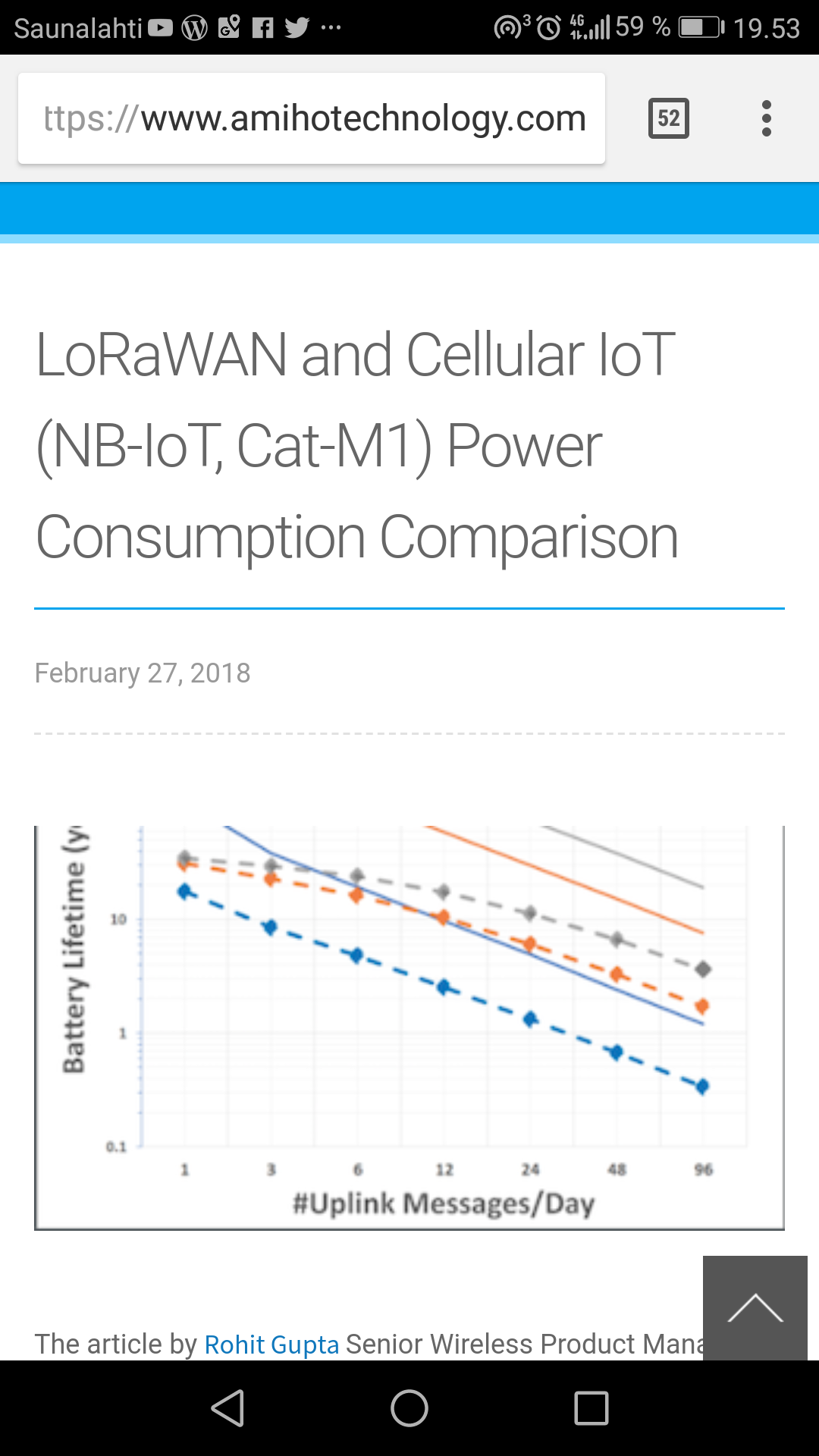https://www.amihotechnology.com/lorawan-cellular-nb-iot-power-consumption-comparison/
The intent of this post is not to say which technology is better or worse. But, rather to show how Cellular IoT and LoRaWAN complement each other.
Battery lifetime is by far one of the most important considerations for LPWAN applications because often it is very expensive to replace batteries physically. It will ruin the ROI if the end-devices last only few years. There are many applications in which device is deployed in hard to reach areas and need battery lifetime of 10+ years.
Every modem whether LoRAWAN or Cellular IoT has to go different states (transmit, receive, Idle and Sleep). It is the current consumption of these states that defines the power consumption calculation.

8 Comments
Tomi Engdahl says:
https://www.telia.fi/yrityksille/artikkelit/artikkeli/rakastunut-kirjelaatikko-iot-newsroom?utm_source=facebook&utm_campaign=B2B_sisältö_nostot_Q1_2018_buP11160003018&utm_medium=social&utm_content=paid_link_LottaTheLetterBox_IoT_SERVICES_follow_up_2018-04-03
Tomi Engdahl says:
LoRa Module VS nRF24 VS Generic RF Module || Range & Power Test
https://www.youtube.com/watch?v=nP6YuwNVoPU
Vivek Jazz says:
Thank you so much for this post. if you have to need a remote connection to operate other desktop in your computer then come to learn there process in this web link http://remotedesktopwindows10.com , this will be free site for all windows user.
Tomi Engdahl says:
NB-IoT
It covers a wide area even in difficult conditions where ordinary cellular networks do not work
Low equipment costs
Low power consumption (battery life of 10+ years)
Easy scalable technology that enables multiple IoT devices to be connected to ordinary cellular networks
Does not support Voice over LTE technology or full mobility
Suitable for stationary sensors with a battery life of several years
LTE M
Cover the wider area of traditional cellular networks
Low equipment costs
Lower power consumption than conventional mobile networks (battery life 5-10 years)
Supports Voice over LTE technology and full mobility
Ideal for applications that require mobility and lower power consumption than traditional cellular networks
Source: https://www.uusiteknologia.fi/2018/04/13/suomalainen-nb-iot-ja-lte-m-alusta/
Tomi Engdahl says:
ETNdigi: LTE-M:n ja NB-IoT:n hyödyt käyttöön testaamalla
http://etn.fi/index.php?option=com_content&view=article&id=8144&via=n&datum=2018-06-21_11:33:49&mottagare=31202
Jon says:
I agree with you. This should be seen by people as something that can help them in order to see if these two complement each other. | https://www.concretecontractorsbirmingham.com
Tomi Engdahl says:
11 Myths About Cellular IoT Design
https://www.electronicdesign.com/technologies/iot/article/21140960/11-myths-about-cellular-iot?utm_source=EG+ED+IoT+for+Engineers&utm_medium=email&utm_campaign=CPS200911058&o_eid=7211D2691390C9R&rdx.ident%5Bpull%5D=omeda%7C7211D2691390C9R&oly_enc_id=7211D2691390C9R
Laird Connectivity’s Jonathan Kaye discusses the most common misconceptions about cellular IoT design—a growing area of IoT thanks to two new versions of the cellular standard that enable battery life of up to 10 years for wireless devices.
Tomi Engdahl says:
https://www.mwrf.com/technologies/embedded/systems/article/21268718/morse-micro-whats-the-difference-between-wifi-halow-and-lorawan?utm_source=RF+MWRF+Today&utm_medium=email&utm_campaign=CPS230630118&o_eid=7211D2691390C9R&rdx.identpull=omeda|7211D2691390C9R&oly_enc_id=7211D2691390C9R